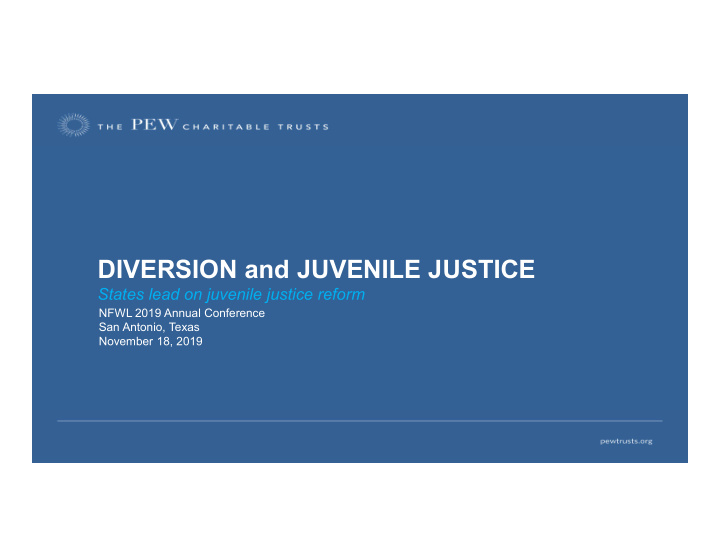



DIVERSION and JUVENILE JUSTICE States lead on juvenile justice reform NFWL 2019 Annual Conference San Antonio, Texas November 18, 2019
Pew and PSPP The Pew Charitable Trusts is a nonprofit organization that applies a rigorous, analytical approach to improve public policy, inform the public, and stimulate civic life. Pew’s public safety performance project (pspp) works with states to advance data-driven, research-informed, fiscally sound policies and practices in the criminal and juvenile justice systems.
Backdrop: Less crime, less commitment National juvenile commitment rate and violent crime rate declines, 1997-2015 300 400 Juvenile violent crime arrest rate 350 Juvenile commitment rate per 250 300 200 250 per 100,000 100,000 150 200 150 100 100 50 50 0 0 1997 1999 2001 2003 20062007 20102011 2013 2015 Note: Violent crime arrests include those for murder, robbery, and aggravated assault
Research: Support for a developmental approach National Academy of Sciences Reforming Juvenile Justice: A Developmental Approach “In general, multifaceted community-based interventions show greater reductions in rearrests than institutional programs.” * * * “There is no convincing evidence … that confinement of juvenile offenders beyond the minimum amount needed for [providing sufficiently intense services], either in adult prisons or juvenile correctional institutions, appreciably reduces the likelihood of subsequent offending .”
Motivation: Variation among states
Motivation: Racial and ethnic disparities Relative commitment rates by race/ethnicity, 1997-2015 5.0 4.5 4.0 Relative Commitment Rate 3.5 3.0 2.5 2.0 1.5 1.0 0.5 0.0 1997 1999 2001 2003 2006 2007 2010 2011 2013 2015 Black Hispanic American Indian White Asian
Motivation: Opportunities denied Military Military Employment Employment Education Education License to Drive License to Drive Enlistment Enlistment Firearm Firearm Family Family Housing Housing Credit Credit Possession Possession Relationships Relationships Registry Registry Immigration Immigration Public Benefits Public Benefits Adoption Adoption restrictions restrictions
Utah Findings: Diversion v. Prosecution Recidivism lower for youth diverted on first charge of misdemeanor, status 60% 51% 49% 49% 49% 48% 50% 40% 39% 36% 36% 36% 40% 30% 20% 10% 0% 2008 2009 2010 2011 2012 % First Intake Resulting in a Nonjudicial - New Charge within 3 Years % First Intake Resulting in a Petition - New Charge within 3 Years
Utah findings: Youth removed from home Most youth in state custody not there for felonies 100% 90% 19% 80% 2% 36% 70% 29% 60% 4% 50% 40% 33% 30% 50% 20% 24% 10% 0% Offense on JJS Community Placement disposition Offense on JJS Secure Placement disposition Felony Misdemeanor Status/Infraction Contempt
Utah findings: Racial and ethnic disparities Racial, ethnic disparities grew at deeper levels of system involvement 120% 100% 80% 60% 40% 20% 0% Utah Youth New Intakes 2015 Probation JJS Community JJS Secure Care DCFS Placement Population 2015 Dispositions 2015 Placement Dispositions 2015 Dispositions 2015 White Non-Hispanic Hispanic Black/African American non-Hispanic Other Race/Ethnicity
Utah Solutions: H.B. 239 Diversion expansion central to Utah’s 2017 data-driven juvenile justice reform bill Augment Standardize Limit secure responses Restrict and expand detention use to non- probation length diversion compliance Narrow Strengthen Keep low-level Heighten placement supervision and school offenses oversight eligibility treatment out of court Expand Reinvest in Reduce time in Revise transfer restorative community and placement to adult system justice EBPs
Utah Results: Diversion doubles Diversion from formal court proceedings rose after HB 239 Proportion of juvenile intakes diverted from formal court proceedings, 2015-18 60% 55% 50% Intakes Diverted 40% 30% 28% 20% 22% 17% 10% 0% 2015 2016 2017 2018 Year
State legislators embrace juvenile diversion • Promoting mandatory or presumptive deflection and diversion for Mandating diversion certain offenses (KS, UT, SD, KY, HI) • Removing certain offenses from court jurisdiction and making them non-arrestable (UT) Shifting jurisdiction • Implementing the use of civil citations for certain behaviors (FL, SD) • Creating incentive funds (SD) Redirecting system resources • Reinvesting savings from placement reductions (KS, UT) Protecting • Restricting use of information shared as part of the diversion confidentiality process (TN, UT) • Creating multidisciplinary teams to collaborate on response to youth Promoting behavior (KY, KS) collaborative • Requiring development of school-justice partnerships to reduce flow stakeholder models of school-based behaviors to law enforcement and courts (GA, KS)
Recommend
More recommend